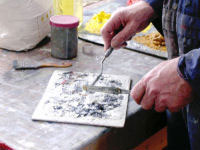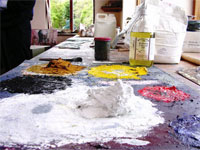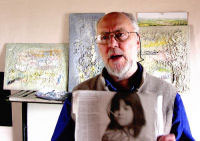The Language of Technique by Brian McAvera
 |
| John Kingerlee working in his studio |
In the early twentieth century artists appropriated the technique. Many writers consider that it was the major, technical innovation of the twentieth century, and it has now become a standard technique for artists world-wide. Most of the major art movements of the century used it, such as Cubism, Futurism, Dada, Surrealism, & Pop Art, not to mention developments of the technique as practised, especially by the Americans, in Assemblage, Happenings, and Combine Paintings.
In terms of art history, as opposed to the history of popular arts and recreations, collage originated when the Cubists, in the shape of Braque and Picasso were making papiers colles [accent on last e] in 1912. In particular they used material from the mass-media such as newspaper articles, newspaper titles, and printed patterns. There were two reasons for this. The first was that they could incorporate a bit of 'reality' into their artwork; and the second was that they could use the collaged pieces as a formal element within the overall composition.
Braque had started the idea by introducing printed letters, and imitations of wood and marble, into his paintings in 1911. It was therefore quite logical to move one small step forwards and introduce real objects, be it wrapping paper, wallpaper, or newspaper. Picasso, in particular, extended the range of materials, introducing wood, cloth, sand, playing cards, & matchboxes.
 |
| John Kingerlee personally mixes his own paints |
After Cubism, the Futurists, in particular Carra & Severini, developed the idea, with Carra creating collages entirely out of words, in which the meanings of the words were as important as the shapes created by them. With collage, flexibility is the key because, as a technique, it constantly expands itself, with artists finding new ways to distort or alienate, or to destroy or integrate, the material at hand.
One particular effect of collage, mined by the Dada movement, was that of juxtaposition, the aim often being to shock. Think of Duchamp putting a moustache onto a postcard of the Mona Lisa, or Man Ray soldering spikes onto what used to be called a smoothing-iron in The Gift. Arp, Picabia, Schwitters and Hausmann also contributed to Dadaist collage. For Schwitters, collage became the central concern of his work. He was particularly interested in the detritus of commerce, such as bus tickets, his art being a primarily formal exploration of the way in which beauty could be made out of unlikely materials.
With Surrealism, artists such as Magritte, Dali and Miro used collage as an alternative to their trompe l'oeil or illusionist paintings, usually producing a 'strange encounter' which has an emotional or dreamlike state. Max Ernst however moved in a different direction, producing collage 'novels' (in particular La Femme 100 Tetes - The Woman with a Hundred Heads in 1929 and Une Semaine de Bonte - A Week of Goodness in 1932) in which he took disconnected fragments from old anatomy books, and from 19th century engravings, re-arranging them according to his imagination.
The view of collage as being about the exploration of formal elements has a lineage that runs from Cubists, Dadaists and Surrealists through to artists like Mondrian, Victor Pasmore, De Stael and Motherwell, (amongst many others), who developed the technique quite consciously, as opposed to the chance or random elements of the Surrealists.
Constructivism, in the shape of Gabo, Archipenko and Pevsner, is closely linked to collage, and it leads directly to Assemblage, in which materials are assembled or fastened together but retain their original identity. With such work the artist is more interested in making links between the various materials, than he is in fashioning a completely new object. Joseph Cornell's boxes would be a good example. A development of this, which occurred in the work of Robert Rauschenberg, in particular, was the Combine Painting in which pre-existing objects, such as a bed, are combined with passages of painting, (cf. Bed, 1955). Assemblage provided a jumping off point for the concepts of The Environment, and The Happening.
A narrower version of collage developed with photomontage, primarily from the thirties onwards, in which the only materials used were photographs. Bits of pre-existing photographs are cut out and re-arranged, then pasted down. This form of collage was mainly created by the Berlin Dadaists who used it for political and propagandistic purposes, the key figures being Raoul Haussman, John Heartfield, and Hannah Hoch. Today it is often used in advertising, but politically orientated artists such as Peter Kennard still utilise it to great effect. In Ireland, Sean Hillen, in collages such as Londo-Newry, continued this tradition.
 |
| John Kingerlee discusses his work |
If one surveys the twentieth century as a whole, the dominant impression, in terms of the use of collage, is its employment in terms of its expressive or aesthetic aspects, and its tendenq' to shift from the two to the three dimensional. This latter element comes to fruition in the use of the Found Object whereby the artist finds, or selects materials, displaying them for the purposes of demonstrating their aesthetic qualities. The locus of this is, of course, Duchamp with his urinals and bicycle wheels. If the found objects are basically two-dimensional (such as paper or card) and are pasted onto a flat surface, (whether linked with passages of paint or not), they are usually called collage. If the found objects are three-dimensional, and are joined or mounted with other objects, then the result is usually called an assemblage.
Although, technically speaking, collage with the addition of painted passages is called a Combine Painting, (as with Rauschenberg), this distinction is rarely used nowadays, so that many artists quite happily either use collage in what is primarily a painting, as with the Northern Irish artist Gerry Gleason, use collage and assemblage techniques as with Paddy Graham (but still call it a painting), or use heavily built up layers of collage which either have painted passages or else are almost entirely painted over as with Kingerlee.
Kingerlee uses various forms of collage. Sometimes, as a baseline, he will stick down pages from a sketchbook, or pages from old Sotheby's auction catalogues, or even text pages from a book. On top of these he will then collage various forms of ephemera, such as entrance tickets, bits of postcards, illustrations from magazines and so forth.
Alternatively he may tear up old drawings or paintings (or other material) and stick them down, building up layers. He calls this process 'Stick and Rip'. In either case, the collaged material is liable to be painted over, or drawn over. Within these techniques, two kinds of work tend to emerge: that which seems to be connected to place, as referenced by postal stamps, postcards, rickets or Libels; and that which builds up into either figures or heads. Within this process he may 'rubback' which is his word for cutting through or rubbing through the paint and paper to reveal a layer which is below.
In Painted Collage 2006 (catalogue no.14), two sketch-book pages, laid side by side, have been affixed to white board. Then they have been lightly brushed with dominant layers of colour (light green, yellow, pinks and light red), then lightly over-painted again in places - the green with the pink, for example. Elements are then collaged on, such as the Pellegrino water label, the 48cent Eire stamp, and what looks like a piece from a postcard, as well as a piece cut out from an envelope which has been placed in the top right corner.
I laving established a loose geography in relation to the page, the elements are then played with, so that the Eire stamp does duty for a head of a Madonna like figure (probably suggested by the religious imagery of the stamp) and created by drawing lines in pencil, Cy Twombly style. Another embryo figure is created in green ink (with black for the head) and a third, to the right of it, emerges in red ink and crayon. Networks of lines, brushstrokes, a sweep of the palette knife (creating a three-dimensional effect with its ridging) either create new shapes, or tie into existing ones. This use of the connecting network of lines is probably borrowed from the drawings of Kurt Schwitters.
By contrast, the Stick and Rip Series III, 2005(catalogue no.53) is a precise descriptive title, in that pieces of previous drawings or paintings, ripped up and then stuck down on the page, are built up into palimpsests. Added into this are other pieces of collage, such as a French train ticket, & the ubiquitous Irish stamp, which has been torn from an envelope. The artist has painted over all of this, most noticeably along the dividing line of the two sketchbook pages used as the baseline for the work, but it is difficult to tell whether the various mark-makings (in pencil, crayon, acrylic, pen etc.) were on the original ripped pieces, or have been added afterwards.
With Sathebys' Series II, 2004 (catalogue no.ll), the baseline consists of pages from old black and white auction catalogues, over which are collaged a section from another catalogue page, and a piece of a Netherlands stamp cut to reveal only the letters 'ETHERLAND'. In places the over-painting has been rubbed back to reveal parts of words such as 'ALT & 'EARE'. A slightly different variation is used in The Balcony Windows: Spain - Kilcatherine, 2006 (catalogue no. 13), where the baseline consists of text pages from a book which have been thickly over-painted, with the paint ridging into impasto blobs in places. The first balcony window is created by the simple device of painting around a small rectangular portion of the text, which had previously been given a light greenish wash of colour. The other window has a similar rectangular shape but has an Eire stamp in the middle of it, to give it its definition. The effect created is of blinding heat and light, but the means used to obtain this effect are simple and spare.
In Vichy, 2006 (catalogue no.27), we have a clue as to what generates these collages. The artist travels continually and works like these seem to be stimulated by memories, not so much of any one particular place but rather of the act of travelling. The baseline is a section of text from an nineteenth century novel, over which is collaged a card from the Hotel Continental in Tangiers, what looks like a section of an advertisement or label for Catalan Vichy water, and various other pieces of sketchbooks pages. Over these, in paint, there are pictographs for faces (as at the bottom right); and ethereal full-length figures drift in and out of the spatial miasma. It's rather like sections of opera gauzes, each with a different image, being floated down onto a stage simultaneously.
Travellers, 2006 (catalogue no.48), opts for another strategy. As with many of these collages, there is a rough and ready feel to the proceedings. Two, possibly three sketchbook pages are collaged together, but this time one of them has been folded back at an angle before being stuck down., thus increasing the three-dimensional aspect. In the middle, but towards the right is a small card with a Morning Prayer on it. Painted on, over and through this card is a traveller on horseback - like an ideograph for Don Quixote - and possibly the partial figure on the right is meant to be his sidekick Sancho Panza. The artist takes advantage of the creases and folds in the paper to create texture, and the landscape background is created very simply, the brush being swiftly pulled over the ridges in the paper, creating the sense of a mass of trees in the distance.
Collage often juxtaposes discrete elements, but this artist tends to use collage to build up a low relief image which is the counterpart of tachiste painting, in which the paint is often very thickly applied, as with Dubuffet or Tapies, both of whom the artist would have seen in London galleries when he was resident there in the fifties. A good example of this is Landscape Composition, Grenada 2006 (catalogue no.3), a tiny work scarcely bigger than a postcard, which has a small oblong piece of sketchbook page collaged centrally. The dark to light blue background has been vigorously swept over, centrally, with a palette knife, creating striking areas of red into black, bright white into blue, and light brown flecked with blue. This could almost be a 1950's tachiste painting as, despite its title, it looks almost abstract. The same could be said of Memories, Collage and Mixed Media, 2006.
If many artists use the associations of their collaged elements for social or political purposes, Kingerlee is not one of them. Charlie Haughey Died This Day, 2006 (catalogue no.31), may seem like some kind of political statement on the basis of its title, but it is much more likely that it simply records the artist's interests on the day that this event was a news item. There is a British (rather than Irish) second class stamp, neatly placed on its side for formal reasons, at the top left, along with the by now familiar pieces of collaged sketchbook pages, and (probably) bits of postcard, the whole being over-painted.
As with so much of the artist's work, the dominant impression is initially abstract, conjuring up tachiste painters from France, the UK and Spain, along with hints of the COBRA group. Here, bearing in mind Haughey's love of horseracing, it's possible that the figure towards the right may be a jockey on horseback - but it might just be random chance. With works like these we are encouraged to read into, rather than read out of them.
Collage is an intriguing area to explore. It is perhaps no accident that when it began to come back into fashion in the UK, in the London of the fifties, the artist was living there. Brian Fallon, in the Irish Arts Review, has suggested that there is a link between the collages of Patrick Hayman and that of the artist, though many other London artists of the fifties could be cited, such as John McHale & Eduardo Paolozzi. Whatever the truth of this may be, artists are drawn towards collage because of the freedom that it gives them, and because, even today, there are new discoveries to be made.
BRIAN McAVERA is an Irish playwright, having written over 25 stage plays, fifteen radio plays, and two films, one of which lie produced and directed. Although he is from Northern Ireland, and spent many years writing and directing political plays, and also co-founding and directing for New Writers' Theatre in Belfast, he is probably best known in relation to the international success of the cycle of eight plays called Picasso's Women which seek to uncover die buried lives of the women in Picasso's life (translated into 9 languages so far) as well as its companion piece Yo! Picasso: Beside Picasso, which sees die story from the point of view of Picasso and his lifelong secretary Sabartes. The recent Kings of the Road views Northern Ireland from a tragic-comic point of view, looking at the lives of busmen over the generations. All of these have been published by Oberon Books, London. Brian is also the author of four books of art history and criticism, over 30 catalogues and about a million words of art criticism. He is a contributing editor of Sculpture (USA) and also State of Art (UK) as well as being a regular contributor to Irish Arts Review. He also curates exhibitions, the next one being a survey of socio-political art during The Troubles, scheduled for the Golden Thread Gallery in Belfast (Jan 2006). Currently he is writing a play about the artist Francis Bacon, a series of three plays on Venetian artists (Titian, Tintoretto & Canaletto), and two musicals, one about the relationship between Henry Miller and Anais Nin; and the other 'suggested' by the life and times of Bob Dylan.